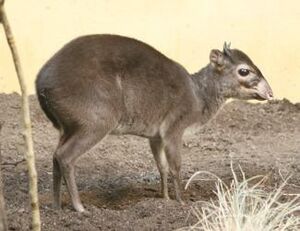Maxwell's duiker facts for kids
Quick facts for kids Maxwell's duiker |
|
|---|---|
 |
|
| Conservation status | |
| Scientific classification | |
| Genus: |
Philantomba
|
| Species: |
maxwellii
|
 |
|
| The range map of Maxwell's duiker | |
| Synonyms | |
|
|
The Maxwell's duiker (Philantomba maxwellii) is a small antelope that lives in western Africa. It is known for its small size and shy nature.
Contents
About Maxwell's Duiker
The scientific name for Maxwell's duiker is Philantomba maxwellii. It belongs to a group of animals called a genus, named Philantomba. In this group, you'll also find the blue duiker (P. monticola) and Walter's duiker (P. walteri).
An English scientist named Charles Hamilton Smith first described this duiker in 1827. Some scientists used to think it belonged to a different group called Cephalophus. However, most experts now agree that Philantomba is its own special group.
Scientists study how animals are related to each other. They use special tests, like looking at mitochondrial DNA, to create family trees. These studies show that the Philantomba group is unique. Maxwell's duiker separated from the blue duiker millions of years ago.
Types of Maxwell's Duiker
There are three main types, or subspecies, of Maxwell's duiker:
- P. m. danei or P. m. lowei (first noted in 1920): Found in Sierra Leone.
- P. m. maxwelli (first noted in 1827): Found in Senegal, Gambia, and Sierra Leone.
- P. m. liberiensis (first noted in 1920): Found in Liberia.
Appearance and Features
Maxwell's duiker is a small antelope, just like others in its group. It has a back that is slightly raised, short legs, a small head, and small, round ears.
These duikers are usually about 63 to 100 centimeters (25 to 39 inches) long, not counting their head. They stand about 35 to 38 cm (14 to 15 in) tall at the shoulder. They weigh around 8 to 10 kilograms (18 to 22 pounds). Their tail is bushy and has white fur, measuring about 8 to 10 cm (3 to 4 in) long.
Female duikers are usually a little bigger than males. This difference between male and female animals is called sexual dimorphism.
Their fur is grayish-brown, sometimes with a hint of blue. The color can change slightly from one duiker to another. A small tuft of hair grows around the base of their horns and between them. Their belly is usually white, which is different from their darker back.
Both males and sometimes females have short, straight, spiky horns. These horns are thick at the bottom and have rings. They are about 3.5 to 6 cm (1.4 to 2.4 in) long. In some areas, like Nigeria and Togo, almost all females have horns. But in places like Liberia, very few females have them.
Maxwell's duiker looks a lot like the blue duiker. However, Maxwell's duiker is about twice as big and heavier. Its skull is also larger. The Maxwell's duiker has a more even color, while the blue duiker often has different colors on its back and rear.
Where They Live
Maxwell's duiker likes to live in places with lots of fresh, thick shrubs and plants. They live in warm, wet lowland forests in western African countries. These countries include Benin, Burkina Faso, Côte d'Ivoire, Ghana, Guinea, Guinea-Bissau, Liberia, Nigeria, Senegal, Sierra Leone, and Togo.
They can also be found at the edges of forests, in forests that have grown back, in scrub forests, and in forests along rivers. Sometimes, they even live near farmlands. Their home range stretches from southwestern Senegal to the Cross River in Nigeria.
What They Eat
Maxwell's duikers mostly eat fruits, seeds, and parts of shrubs. They also eat other plants. Scientists have found that Maxwell's duikers eat similar foods to other duikers living in the same areas. What they eat can change with the seasons. For example, at the start of winter, they might eat more leaves and parts of flowers.
Because they are small, they tend to eat smaller food items. Their small mouths and body structure mean they usually eat things that are up to 3 cm (1.2 in) wide. Larger duiker species can eat items up to 6 cm (2.4 in) wide.
Behavior
Maxwell's duikers have a special preorbital gland near their eyes. They use this gland to mark objects and other duikers with their scent. Dominant males often do this.
Scientists first noticed this behavior in duikers. Scent marking also helps them recognize each other or show they are friendly. Males and females will often press these glands together on each other's faces.
Reproduction and Life Cycle
Maxwell's duiker calves are mostly born during Africa's two dry seasons. Females usually give birth to one calf each year. The mother carries the baby for about 120 days before it is born.
Newborn calves usually weigh about one-tenth of their mother's weight. They look similar in color to baby duikers of other species. In zoos or other protected places, Maxwell's duikers can live for up to 10 years.
Threats and Conservation
The International Union for Conservation of Nature and Natural Resources (IUCN) lists Maxwell's duiker as a species of Least Concern. This means they are not currently in danger of disappearing. However, the number of Maxwell's duikers is slowly going down. This means conservation efforts are still important to protect them.



